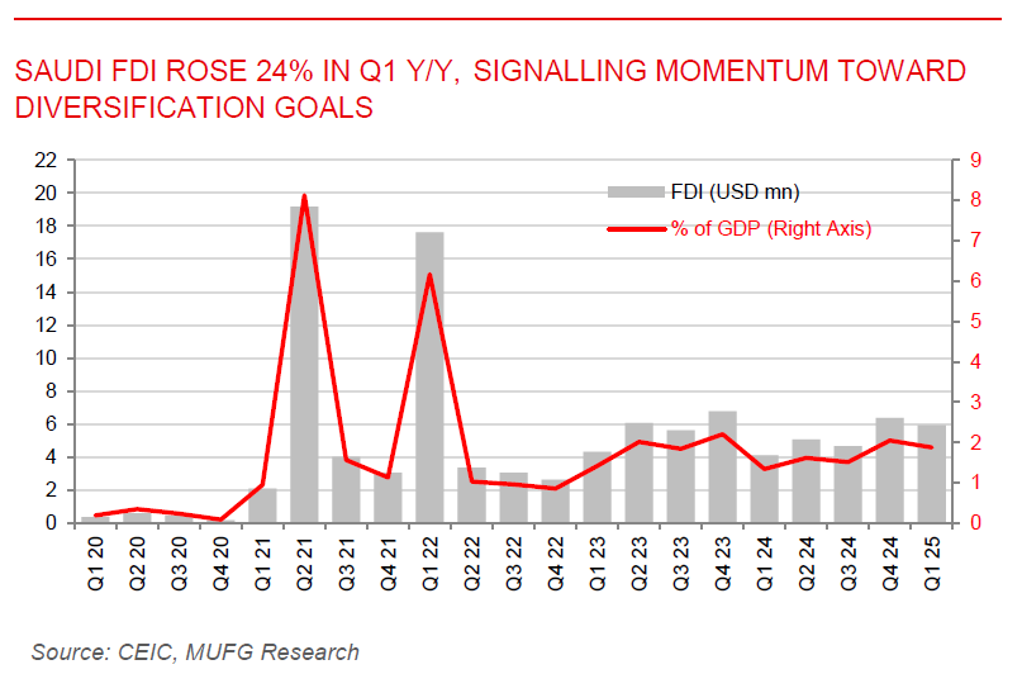To read the full report, please download the PDF above.
Middle East Daily
SOOJIN KIM
Research Analyst
DIFC Branch – Dubai
T: +44(4)387 5031
E: soojin.kim@ae.mufg.jp
MUFG Bank, Ltd. and MUFG Securities plc
A member of MUFG, a global financial group
Middle East Daily
COMMODITIES / ENERGY
Oil extends decline as traders shift focus to OPEC+ supply. Oil prices fell on 30 June, continuing their sharp slide after last week’s 12% drop, the steepest weekly loss in over two years, as traders positioned for a potential OPEC+ output hike and turned bearish amid easing geopolitical risk. Brent crude dipped to just above USD67/b while WTI hovered near USD65/b, with hedge funds ramping up short bets following the fragile Israel-Iran ceasefire. OPEC+ members are reportedly considering a 411,000b/d supply increase for August, marking a fourth consecutive month of aggressive hikes aimed at protecting market share. With oil not near pre-conflict levels, focus has shifted to oversupply concerns and muted global demand. While China’s factory activity showed modest improvement, the broader demand picture remains soft. Meanwhile, looming US tariff deadlines and ongoing trade negotiations are adding another layer of uncertainty to the outlook.
Gold edges higher as dollar softens and markets watch trade and tax developments. Gold rose slightly to USD3,280/oz on 30 June, supported by a weaker dollar and cautious optimism over US trade talks and a potential USD4.5 trillion tax cut package. After falling as much as 0.8% earlier in the day, gold pared losses amid signs the US may be nearing trade deals with several countries ahead of the 9 July tariff deadline, though the scope of these agreements remains unclear. Meanwhile, focus also turned to Senate negotiations over the tax bill, which has faced resistance due to its fiscal cost. Gold is still up about 25% YTD, bolstered by haven demand earlier in the year, but is on track for its first monthly loss in 2025 as geopolitical risks fade and US economic data improve.
MIDDLE EAST - CREDIT TRADING
End of day comment – 27 June 2025. Very quiet trading day with Islamic New Year holiday and international Friday trading lull. With the UST move overnight cash opened to the right, but only KSA and PIFKSA traded mostly in the street. The afternoon saw a slight pick-up in activity. There were mainly sellers of QATAR/ QPETRO from international accounts. It seems here that the EMBI exclusion flows are not yet finished and selling flows increasing into quarter end next week. QATAR sovereign curve going out up to -0.25pt lower in cash and 2/3bp wider. All other credits though closed broadly unchanged and 1/2bp tighter on the day. ADGB continues to have a good bid in the long end 54s closing +0.25pt/-2bp. OMAN did see 29s squeezing again closing +0.25pt/-5bp whereas the rest of the curve closed unchanged +1bp on average. With volumes less than 50% of an average day not much else to report.
MIDDLE EAST - MACRO / MARKETS
Saudi FDI rose 24% in Q1, signalling momentum toward diversification goals. Saudi Arabia recorded USD6.4bn in foreign direct investment (FDI) in the Q1 2025, the strongest Q1 performance since 2022 and a 24% y/y increase, signalling growing momentum in its drive to attract overseas capital for Vision 2030. While slightly down from the previous quarter’s one-year high, the result reflects renewed traction after a period of stagnation. The uptick comes as the kingdom faces rising budget pressures from low oil revenues and elevated spending, heightening the need for foreign capital. To meet its ambitious USD37bn annual FDI target, Saudi Arabia will need a record year. Separately, net foreign assets rose to USD435bn, the highest since August 2024, and unemployment fell to a record low of 6.3%. The IMF has raised its Saudi GDP growth forecast to 3.5% for 2025, citing labour market strength and economic resilience.
Israel resumes full gas exports to Egypt following ceasefire. Israeli natural gas exports to Egypt have returned to normal levels of 1Bcf/d, following the reopening of key facilities after a 12-day conflict with Iran. Output had dropped sharply when Israel shut down its Leviathan and Karish gas field in mid-June, with flows reduced to just 260MMcf/d. The US-brokered ceasefire allowed operations to resume, restoring critical supply to Egypt, which had been forced to ration gas to industries and switch power plants to fuel oil and diesel. The renewed flows provide relief to Egypt as it continues to face challenges balancing domestic energy needs after shifting from a gas exporter to importer in recent years.

